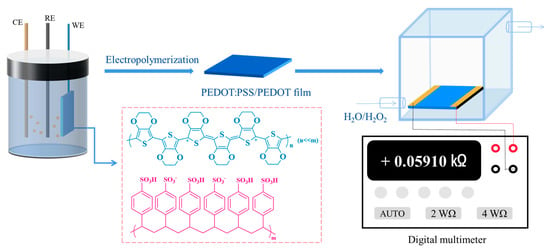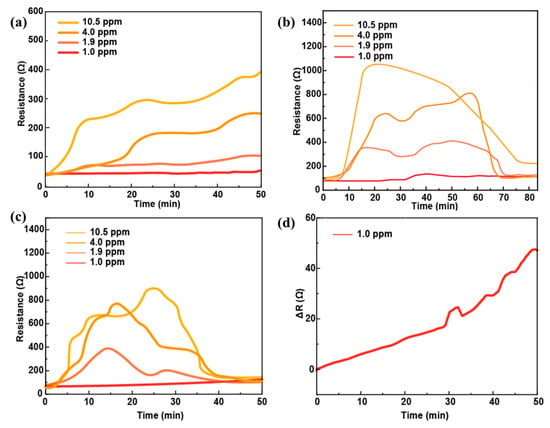Abstract
Compared with other gas-phase analytes, the coexistence and competing effect of the moisture component has long created great difficulty and technical challenges for the reliable detection of chemically oxidizing active H2O2 vapor (HPV). Recently, our group designed and prepared a chemiresistive sensor based on conductive films of poly(3,4-ethylenedioxythiophene) (PEDOT), poly(3,4-ethylenedioxythiophene):polystyrene sulfonate (PEDOT:PSS), and PEDOT:PSS/PEDOT to achieve direct detection of HPV at the ppm level. Specially, the hydrophobic PEDOT layer was polymerized on the surface of the PEDOT:PSS film using the electrochemical method to attenuate the adverse effect of moisture within HPV on the stability and detection performance of the PEDOT:PSS/PEDOT sensing film.
1. Introduction
Hydrogen peroxide (H2O2) is a colorless and transparent aqueous solution with a weak odor. It is widely used as an environmentally friendly and efficient oxidation and disinfection agent with many domestic, industrial, and environmental applications [1]. HPV is a volatile matter of hydrogen peroxide, which has two components: oxidative H2O2 and moisture. However, in view of the differences in diffusion degree and exposure time, the strong oxidizing properties of H2O2 may still cause corrosion and irritation to human skin, eyes, and mucous membranes, and the oxidative stress generated by free radicals after H2O2 enters the human body may lead to cellular damage and disease, accelerate the aging of the human body and cause respiratory diseases, inflammatory diseases, cancers, and so on. The threshold value of H2O2 has a limit of 1.0 ppm and the short-term exposure (15 min) limit is 2.0 ppm, which is stipulated by the American Conference of Governmental Industrial Hygienists (ACGIH) [2]. Moreover, its oxidative function depends on the coexisting moisture, but moisture will inevitably affect its accurate detection. Therefore, compared with other gas-phase analytes, the reliable detection of HPV faces great difficulties.
In view of the preparation of gas sensors, the detection sensitivity and response speed of analytes have often been improved by adjusting the microstructure and porosity of gas-sensitive films. Constructing a composite material system with a controlled structural morphology has been an effective way to improve sensor response [3]. The conducting polymer poly(3,4-ethylenedioxythiophene) (PEDOT) film polymerized using electrochemical means has a certain porosity which can improve the adsorption capacity of gas molecules, thereby improving the performance of sensors [4]. Poly(3,4-ethylenedioxythiophene):polystyrene sulfonate (PEDOT:PSS) has the advantages of excellent film processing under a wide selection range of film formation techniques, high tolerance for the choice of substrate, high film conductivity, and easier compositing with other materials, etc. [5], and it has been investigated for the detection of H2O2 in liquid-phase systems using electrochemical methods [6]. In our work, PEDOT:PSS film was evenly coated on an ITO conductive glass substrate with a commercially purchased aqueous dispersion (CLEVIOSTM PH1000) through a desktop coater, and the properties of the film were controlled by the spin-coating conditions, parameters, and drying condition index. PEDOT:PSS/PEDOT composite films were prepared on the basis of the above-prepared PEDOT:PSS films, which were used as working electrodes, by building a three-electrode electrochemical experimental apparatus and using an electrochemical workstation to electropolymerize EDOT monomer using the chronoelectric method. For comparison, PEDOT film was also prepared by electrochemically polymerizing EDOT under the same electrolyte systems. Finally, the resistance signal response of these films to HPV was tested and analyzed contrastively.
2. Results and Discussion
In order to evaluate the sensing response of these PEDOT-based sensing films to HPV, a self-made test device system (Figure 1) was built [6]. PEDOT:PSS film was successfully used as a chemiresistive probe for HPV sensing, which can meet the concentration and response time of the H2O2 threshold limit.

Figure 1.
Schematic diagram of the device used to evaluate the HPV sensor.
In comparison, PEDOT films have a certain hydrophobicity and satisfied porous morphology, and thus the effect of moisture on the structure and HPV response of the gas-sensitive film can be attenuated, and the sensing performance of the gas-sensitive film for HPV can be improved. After exposure to HPV, the resistance of the PEDOT film continued to increase with exposure time, and the value of the change in PEDOT film resistance decreased with decreasing HPV concentration (Figure 2a). For the response to HPV at a concentration of 1.9 ppm, the resistance of the PEDOT:PSS film reached the first peak in 12 min, which was able to meet the safety threshold (2.0 ppm, 15 min) (Figure 2b). Compared to the PEDOT:PSS film, the PEDOT:PSS/PEDOT composite film showed an approximately 97% improvement in resistance response to HPV at the same concentration (Figure 2c). In contrast, the effect of HPV at a low concentration of 1.0 ppm on the resistance value of the PEDOT:PSS/PEDOT composite film of HPV adsorption and resistance response (ΔR/R0) resulted in an unsaturated state for the given detection time (50 min, 0.72) but still exhibited a nearly 89% higher resistance response compared to the PEDOT:PSS film (50 min, 0.38) (Figure 2d). Due to the simultaneous existence of PEDOT:PSS and PEDOT, although the resistance signals of PEDOT:PSS film were still affected by moisture, the PEDOT layer on its surface can partly protect it from interference and provide an increased contact area and diffusion channel to enhance the adsorption rate of HPV and correspondingly improve the signal response.

Figure 2.
(a) Resistance–time curve of PEDOT film to different concentrations of HPV; (b) resistance–time curve of PEDOT:PSS film to different concentrations of HPV; (c) resistance–time curve of PEDOT:PSS/PEDOT (30 mC) composite film to different concentrations of HPV; and (d) resistance change–time curve of PEDOT:PSS/PEDOT (30 mC) composite film to 1.0 ppm HPV.
3. Conclusions
In summary, PEDOT:PSS/PEDOT films were prepared by quantitative deposition via electrochemical polymerization, and the effect of surface loading of PEDOT was systematically investigated on the electrical properties, moisture stability, and response of PEDOT:PSS, as well as the resistive signal response to HPV. The results demonstrated the effectiveness and availability of all-organic semiconductor films for nonenzymatic sensing of chemically active gases, even under a high-moisture environment. In the future, the rich structural design and processing methods of PEDOT-based materials can be used to regulate and optimize the composite systems themselves and their sensing performance from various aspects. Moreover, it is also worth developing PEDOT-based sensing systems with dual or multiple signal responses to enhance the accuracy and reliability of HPV detection.
Author Contributions
Conceptualization, S.C.; methodology, S.C. and N.G.; software, L.Z., N.G. and X.X.; validation, N.G. and X.X.; formal analysis, L.Z.; investigation, N.G. and S.C.; resources, S.C.; data curation, N.G. and X.X.; writing—original draft preparation, L.Z., N.G. and X.X.; writing—review and editing, S.C.; supervision, S.C.; funding acquisition, S.C. All authors have read and agreed to the published version of the manuscript.
Funding
This work was funded by the Academic Development Project of TongXin Funds (grant number 2023161807).
Institutional Review Board Statement
Not applicable.
Informed Consent Statement
Not applicable.
Data Availability Statement
Not applicable.
Conflicts of Interest
The authors declare no conflict of interest.
References
- Berger, D.; Gundermann, G.; Sinha, A.; Moroi, M.; Goyal, N.; Tsai, A. Review of aerosolized hydrogen peroxide, vaporized hydrogen peroxide, and hydrogen peroxide gas plasma in the decontamination of filtering facepiece respirators. Am. J. Infect. Control 2022, 50, 203–213. [Google Scholar] [CrossRef] [PubMed]
- Dewey, H.M.; Jones, J.M.; Keating, M.R.; Budhathoki-Uprety, J. Increased use of disinfectants during the COVID-19 pandemic and its potential impacts on health and safety. ACS Chem. Health Saf. 2022, 29, 27–38. [Google Scholar] [CrossRef]
- Chen, S.; Slattum, P.; Wang, C.Y.; Zang, L. Self-assembly of perylene imide molecules into 1D nanostructures: Methods, morphologies, and applications. Chem. Rev. 2015, 115, 11967–11998. [Google Scholar] [CrossRef] [PubMed]
- Dunst, K.; Karczewski, J.; Jasiński, P. Nitrogen dioxide sensing properties of PEDOT polymer films. Sens. Actuators B Chem. 2017, 247, 108–113. [Google Scholar] [CrossRef]
- Gao, N.; Yu, J.Y.; Tian, Q.Y.; Shi, J.; Zhang, M.; Chen, S.; Zang, L. Application of PEDOT:PSS and its composites in electrochemical and electronic chemosensors. Chemosensors 2021, 9, 79. [Google Scholar] [CrossRef]
- Xie, X.W.; Gao, N.; Zhu, L.; Hunter, M.; Chen, S.; Zang, L. PEDOT:PSS/PEDOT film chemiresistive sensors for hydrogen peroxide vapor detection under ambient conditions. Chemosensors 2023, 11, 124. [Google Scholar] [CrossRef]
Disclaimer/Publisher’s Note: The statements, opinions and data contained in all publications are solely those of the individual author(s) and contributor(s) and not of MDPI and/or the editor(s). MDPI and/or the editor(s) disclaim responsibility for any injury to people or property resulting from any ideas, methods, instructions or products referred to in the content. |
© 2023 by the authors. Licensee MDPI, Basel, Switzerland. This article is an open access article distributed under the terms and conditions of the Creative Commons Attribution (CC BY) license (https://creativecommons.org/licenses/by/4.0/).